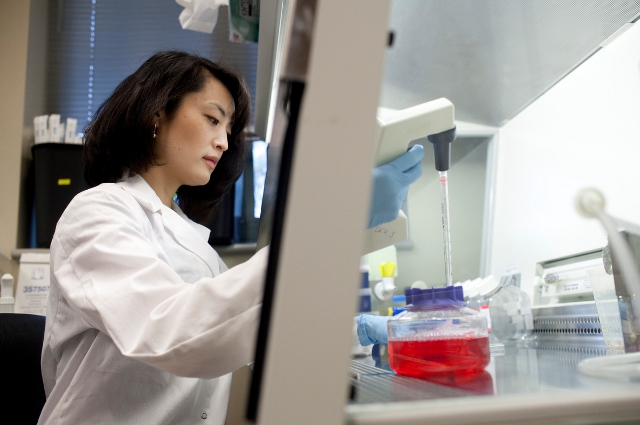The work of biomedical engineer Catherine Kuo could advance the treatment of orthopedic deformities before a baby is born

“I’m a card-carrying engineer who asks biological questions and knows enough about biology to do some,” says Catherine Kuo. “The inclination in a lot of my research is to look at the engineering aspect first.” Photo: Kelvin Ma
- Clubfoot, one of the most common orthopedic birth defects in the United States, affects more than 4,000 newborns each year. The feet of kids with the disorder are drastically out of alignment, pulled downward and inward by unusually tight tendons and ligaments in the ankle. Without braces or multiple corrective surgeries, a child will never walk without a pronounced limp.
Exactly what goes wrong in these tendons is still unclear, but Catherine K. Kuo is trying to figure that out by studying how they form in a developing embryo. Examining these structures in utero is difficult at best, so Kuo is making tendons that mimic those in the womb.
“If we engineer embryonic-like tendons, we can actually study them [in the lab],” says Kuo, an assistant professor of biomedical engineering at Tufts. “It doesn’t have to be in the womb.”
Welcome to developmental biology as seen through the lens of an engineer.
Prior to her life in academia, Kuo worked in the sports industry, designing and testing snowboards in Oregon. That led to a Ph.D. in materials science and engineering, and a postdoc in a stem cell and developmental biology lab at the National Institutes of Health. “I’m a card-carrying engineer who asks biological questions and knows enough about biology to do some,” she says. “The inclination in a lot of my research is to look at the engineering aspect first.”
It seems natural, then, that she’s working with tendons and ligaments. They carry the brunt of the body’s physical load, transferring forces from muscles to bone and stabilizing joints.
To build them, Kuo gathers tendon cells from chicken and mouse embryos and then seeds them into a scaffold, a sort of porous, biodegradable substance made in the lab. It acts as a cradle for the developing cells, giving them a structure in which to grow and mature.
Once the cells start to develop, Kuo puts the cell-seeded scaffolds into a custom-made enclosure that can simulate conditions inside the womb, called a bioreactor. Using computer controls, she’ll regularly flex and bend the lab-grown ligaments and tendons, increase or decrease pressure on them, and mimic muscle movement inside a developing fetus to see how her engineered tissues react. It’s possible, she says, that even small movements like kicking or twisting may change the way tendons and ligaments develop.
Engineering Tendons
Kuo is also designing scaffolds with different physical properties to understand why some tendons form in wrong ways, as in clubfoot. From the perspective of a tendon cell, she says, the difference between sitting in a soft scaffold and a hard one feels like the difference between dozing on a mattress or on a concrete floor. Each condition may cause the cells to respond in distinct ways, producing different proteins than normal, or even activating different genes. Kuo hopes that measuring these subtle changes will shed light on how abnormal tendons form in the first place.
“If we engineer a tendon with a different kind of stiffness than you’d normally see, does that steer cell development off course?” she asks. “Is it because the cells are sending different signals than they would in a normal environment, and maybe that’s why they’re not developing healthy tendon tissue?”
It’s too early to tell just how these physical effects come into play, but if Kuo’s research can eventually show how tendon development goes awry, it may help other scientists counteract the process. Her research is supported by a two-year, $150,000 Basil O’Connor Starter Scholar Research Award from the March of Dimes Foundation.
“If physical forces are negatively influencing development [in a fetus],” she says, “then maybe we can alter them. Maybe there’s some type of brace or scaffold that you can put on the tissues as they’re forming in utero so they experience something closer to normal development.”
Kuo is quick to add that this sort of treatment is a long way off. Right now, she and her research team are still trying to answer basic questions about developing tendons. As they get to the bottom of one puzzle, oftentimes two more pop up. But that, she says, shows that they’re making progress.
“This research is really dynamic, and the data guides us. We ask one question, and we get an answer to something else we didn’t realize we should have asked. And we find that to be just as interesting, if not more, than the original question.”







